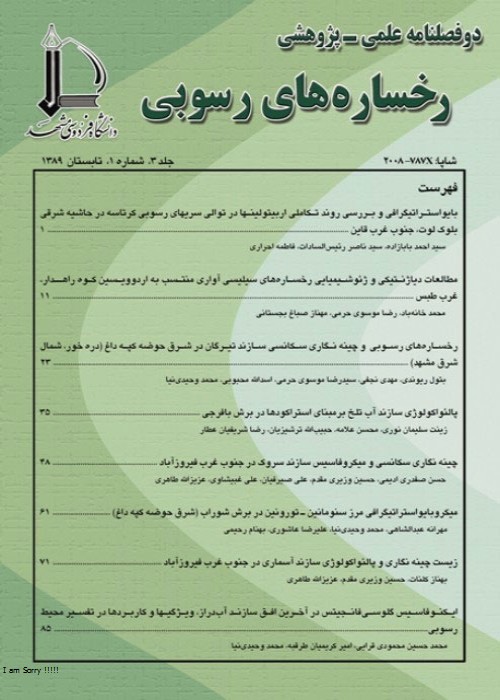Permian Corals of the Bagh-e-Vang member of the Jamal Formation at the North of Tabas, their stratigraphic and biogeographic position
Coral fossils of Jamal Formation Bagh-e-Vang member in Bagh-e-Vang and Shesh-Angosht stratigraphic sections (Tabas area of East-Central Iran) have been investigated in this research. Except the studies by Flügel (e.g.; 1964, 1968, 1972, 1995) and Ezaki (1991) Permian corals are poorly known from Iran. The Jamal Formation was firstly introduced by Stöcklin et al. (1965) for the Permian rocks of east central Iran consisting mainly of limestone and dolomite in Shotori and Shirgesht Mountain ranges of the Tabas Block. With 293 to 473 m thickness (Stöcklin et al., 1965; Ruttner et al., 1968; Leven and Vaziri Mohaddam, 2004), its succession confined unconformably upon eroded surface of siliciclastic rocks belonging to the Carboniferous Sardar Formation and is conformably overlain by the Lower Triassic Sorkh Shale Formation (Partoazar et al., 2014). Jamal Formation in the studied sections is divided into 2 members, Bagh-e-Vang and Cherty Limestone member. The first one which is the main subject of the current research consists of shale and fossiliferous limestone with a siliciclastic rock unit of conglomerate and sandstone at the base, which is overlaid on the green shales of the Sardar Formation. The member is overlaid by cherty limestone of the Jamal Formation through a conglomeratic horizon. This study discuss paleontologically and paleobiogeographically the new material collected from the Jamal Formation in the mentioned localities, Bagh-e-Vang (coordinates of N33°58′27″ and E56°47′33″) on the southwestern flank of the Bagh-e-Vang Mountain and Shesh-Angosht (coordinates of N33°59′15″ and E56°46′50″) on the western flank of the Shesh-Angosht Mountain, at the north of Tabas.
Beside the lithostratigraphical studies in the field, we looked the whole succession of the Bagh-e-Vang member to investigate the coral contents. Totally more than 350 specimens of in situ and float solitary and colonial corals have been collected bed by bed. The specimens were immersed in cold water for one week for study to remove the soft sediment particles attached to them with a special brush. Subsequently, the descriptive characteristics of the specimens included external features such as overall shape, length, diameter, diameter, base and calyx diameter, presence or absence of transverse and longitudinal bands, preservation and wall thickness, rejuvenation, columella and its diameter and depth of calyx were recorded in the respective tables and photographed from various positions with a Canon XD60 camera. In addition, coral fossils serially sectioned in the transverse and longitudinal directions according to the size and conditions of the study. They were studied under normal light (PPl) binocular microscope with a magnification of 5. In the thin section studies, coral diameter, dissepimentarium thickness, number of dissepiment rows, their size and slope, types of dissepiments, central structure, number, shape and thickness of septa as well as their types (Alar septa, cardinal septa, etc.), granule, fossula, tabularium and their number in cm, tabular diameter, type of wall, its thickness and ornamentation, central area diameter and septotheca were investigated. The final determination is carried out based on the proper literatures such as Flügel (1964, 1972, 1990), Ezaki (1991), Flügel & Hubmann (1993), Fedorowski (2010), Berkowski (2012), Kossavaya et al. (2012), Somerville et al. (2012).
The stratigraphic interval in which all examined tabulate corals occur represents the lowest ca. 60 m part (= Bagh-e Vang Member in Partoazar, 1995), where carbonate facies are sandy to marly and contain interlayers of sandstone, shale, and olistolith. The Bagh-e-Vang member was dated by various taxa. These results are as follows: Bolorian (=Kungurian; fusulinids; Leven and Vaziri Mohaddam, 2004), Yakhtashian (=Artinskian) to Bolorian (fusulinids; Arefifad, 2006), Artinskian to Kungurian (bryozoans; Ernst et al., 2006), Bolorian to early Kubergandinian (=early Roadian; fusulinids; Leven and Gorgij, 2011), and Sakmarian to Kungurian (conodonts; Voulo, 2014). Taking these information into consideration, the age of corals examined herein is best constrained as late early Permian. The Tabas Block forms the Central-East Iranian Microcontinent with the Yazd and Lut blocks, whose paleogeographic position is interpreted to have been part of northern margin of Gondwana during early Permian time (e.g. Berberian and King, 1981; Ruban et al., 2007). It is concluded that, therefore, habitat of the Jamal coral assemblage was on the southern shelves of the Paleotethys.The coral assemblage of the Bagh-e-Vang member comprises 27 genera, 2 subgenera, 35 species, and 6 subspecies belong to 20 families of solitary and cerioid-fasiculate colonial Rugosa and Tabulata corals. This fauna is similar to Early Permain (Sakmarian – Kungurian) assemblages of the Cimmerian blocks. They are categorized into two distinct Waagenophyllum and Cyathaxonia fauna; although the Cyathaxonian forms with more diversity and abundance are dominant in the studied sequences. The Fasciculat and cerioid colonial genera of the Waagenophyllum fauna approve the shallow warm water tropical realms of the Tethys Ocean, however the small solitary Cyathaxonia fauna mostly tends to cool - temperate antitropical, antiequatorial or bipolar realms of the northern and southern hemispheres in the Permian (Wang et al., 2013). It means the Cyathaxonia fauna of the Bagh-e-Vang member are comparable with the Pri-Gonwanan realm and the Waagenophyllum fauna are similar to those from North and South China in the tropical realm. Consequently, the Early Permian coral fauna in the Bagh-e-Vang member suggests a complex paleobiogeographic pattern consist of tropical Waagenophyllum and cool-temperate Cyathaxonia fauna.
-
Middle Devonian-Early Carboniferous microscopic fish remains from Khoshyeilagh Formation, Mighan section, Eastern Alborz
Hamta Ranjbar, *, Hossein Gholamalian, Vachik Hairapetian
Geosciences Scientific Quarterly Journal, -
Lithostratigraphy and biostratigraphy of Wuchiapingian succession in the Qareh-Goz section (south of Julfa, northwest of Iran) based on brachiopods
Parisa Mohammadi, *, Ali Reza Ashouri
Geosciences Scientific Quarterly Journal,



